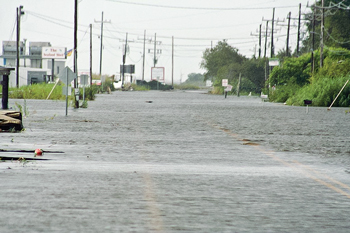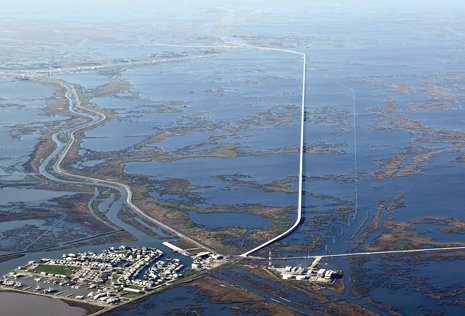Frustrated local officials are looking into all available coffers, as the federal government once again has balked at releasing funds to help complete the phased-in replacement of an oft-impassable Lafourche Parish highway. Even one of the federal government’s most powerful agencies recently declared the highway to be an indispensable cog in the nation’s energy and economic security.
At issue is the U.S. Department of Transportation’s (DOT) denial last December of a slimmed-down grant request to help fund the first segment in Phase II of the critical Louisiana Highway 1 (LA 1) Improvement Project. The unsuccessful application was submitted in October 2011—the latest funding request in the more-than-16-year effort to construct an elevated, storm-proof highway to replace the deteriorating, habitually submerged, southernmost terminus of LA 1. When not underwater from even relatively minor storms (Fig. 1), the aging, heavily traveled highway, much of which is said to be slowly sinking into the surrounding marshes, provides the only access to and from the strategic deepwater hub of Port Fourchon, which supports as much as 18% of the nation’s oil and gas requirements.
 |
| Fig. 1. In 2011, LA 1 was left totally submerged and closed for 61 hours following mild Tropical Storm Lee, shutting off all access to Port Fourchon. |
|
“We’re disappointed that the secretary of the DOT did not agree to play a role in building a road critical to the nation’s energy security, and one that is getting more vulnerable by the day,” said Henri Boulet, executive director of the close-knit LA 1 Coalition. “We’re disappointed, but not deterred. The coalition continues to aggressively seek federal funding opportunities from multiple sources to advance construction of Phase Two of the project. It will be all hands on deck in 2012, with funding for Phase Two our primary focus.”
What makes the latest rejection especially dumbfounding is that it came on the heels of a U.S. Department of Homeland Security (DHS) study that less than two weeks earlier had concluded that a 90-day closure of 7.1 miles of LA 1 would result in an estimated $7.8-billion loss in gross domestic product (GDP). Results of the study released on Dec. 6, 2011, also determined that a three-month closure of LA 1, coinciding with major hurricane damage to the OCS E&P infrastructure, would generate a double whammy that would reduce oil and gas production by about 160 million bbl of oil and 320 Bcf of natural gas, respectively, for as long as a decade. The DHS’ “Louisiana Highway 1/Port Fourchon Study” was prepared in conjunction with the National Infrastructure Simulation and Analysis Center (NISAC) and the University of Louisiana at Lafayette’s National Incident Management Systems and Advanced Technologies Institute.
Supporters of the effort to replace the existing LA 1 say the urgency is even more acute, as Gulf of Mexico deepwater drilling activity begins a steady recovery. According to the LA 1 Coalition, commercial truck traffic on the highway was significantly higher in December 2012, compared to the like period a year earlier, and it continues to rise month after month. In addition, predictions of more frequent, stronger storms slamming the Louisiana coast in the years to come leaves thousands of residents and workers essentially defenseless, considering that LA 1 is the area’s only evacuation route.
A YEAR OF MILESTONES
The most recent economic setback notwithstanding, the coalition closed out a record year, highlighted by the mid-December opening of a 5.4-mile elevated expressway that links Port Fourchon with the nearly $166-million Tomey Doucet Overpass in Leeville that opened in mid-2009, Fig. 2. The overpass replaced the more than 50-year-old Leeville Bridge that had long been regarded as the “weakest link” in decaying LA 1.
 |
| Fig. 2. Aerial view of the new, 5.4-mile elevated expressway that opened in December 2011, linking Port Fourchon with the Tommy Doucet overpass. Source: Gulf Coast Photo |
|
“The past year has truly been one for the record books,” said LA 1 Coalition Chairman Ted Falgout, who until his 2010 retirement was the first and only executive director of Port Fourchon . “After more than four years of construction, we celebrated the extraordinary completion of a two-lane elevated highway to Fourchon, securing access from Leeville to this nation’s energy port.”
Those heavily involved in the ongoing effort say the real celebration will come when the nine-mile, $320-million second phase, which stretches from Golden Meadow to Leeville, is open to traffic. To get to that point, the project’s promoters say they will look at all possible sources of federal, state and private financing.
According to Boulet, the coalition is paying particular attention to congressional dialog on proposed OCS royalty sharing that would divert incoming funds from oil and gas production into revamping critical infrastructure, of which LA 1 would certainly qualify. He said U.S. reauthorization of the 2005 Safe, Accountable, Flexible, Efficient Transportation Equity Act: A Legacy for Users (SAFETEA-LU) offers another possible funding option, as do assorted U.S. highway, jobs and energy bill proposals.
LENDER-FRIENDLY REQUESTS
Last year’s denial of federal funding came nearly a year after the coalition was turned down for a $100-million request, that along with committed state and private monies, would have gone a long way to completing the entire Phase II network. In the early 2010 funding appeal, the group targeted construction funds held by the then-fledgling Transportation Investment Generating Economic Recovery (TIGER) program, which the Obama administration created to both renovate the nation’s infrastructure and spur job growth.
Following that rejection, the LA 1 Coalition, comprising local and state officials, as well as residents and industry representatives, went to the cutting board in an attempt to reduce the sticker shock of budget-weary federal officials. The Louisiana Department of Transportation, in turn, agreed to redesign the Phase II network, dividing it into three segments that call for incremental funding of $45 million, $215 million and $60 million, respectively.
In making its latest application more lender-friendly, the coalition had sought $18 million from the third installment of the TIGER program for the first segment in Phase II, which entails a three-quarter-mile elevated tie-in to the existing four-lane LA 3235. The U.S. DOT was not swayed, even though the application included committed state and private funds to cover the remainder of the $455-million price tag.
Undaunted, Boulet said the coalition will continue to hammer away at the national security risks inherent in not rebuilding a dying infrastructure that the U.S. Congress in 2001 put on its list of “High Priority Corridors.”
“Once again, in our (2011) TIGER grant application, we stressed the critical role LA 1 plays in the nation’s economy and energy security, as well as the highway’s increased vulnerability, due to subsidence and sea level rise,” said Boulet. “Clearly, there is no question as to the importance of the LA 1 Improvement Project to American jobs and our nation’s economy, and the critical need to improve the highway north of Leeville.”
While the DHS study concluded that other Gulf Coast ports could assume about 25% of the services that Port Fourchon provides, it also determined the substitution would be costly. “At this rate of substitution, it is likely that deepwater production of oil and gas could be maintained at normal levels during a Port Fourchon disruption, but deepwater drilling and maintenance activities could not be provided,” the investigators determined. 
|




